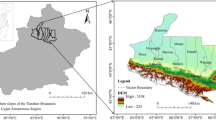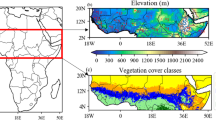Abstract
Empirical Orthogonal Function (EOF) analysis and the related Principal Components (PC) analysis are used to extract valuable vegetation cover derived information from the National Oceanic and Atmospheric Administration (NOAA-AVHRR)’s Leaf Area Index (LAI) satellite images. Results suggest that from 1982 to 2000 global climate change has contributed to an increase in vegetation cover in the Qinghai-Tibet Plateau. The correlation between rainfall and LAI EOF PC1 and PC2 indicates that rainfall is the major climatic factor influencing interannual variations of average vegetation cover throughout the entire Plateau. However, annual mean vegetation cover trends in the Qinghai-Tibet Plateau are mainly out of phase with air temperature increasing, which is primarily responsible for nonsynchronous changes of vegetation cover. In the southern ridge of the Qinghai-Tibet Plateau, recent warming trends contribute to humid weather and favorable conditions for vegetation growth. By contrast, higher temperatures have led to arid conditions and insufficient rainfall in the northern part of the Plateau, leading to drought and other climatic conditions which are not conducive to increased vegetation cover.
Similar content being viewed by others
References
Wei Z G, Huang R H, Dong W J. Interannual and interdecadal variations of air temperature and precipitation over the Tibetan Plateau. Chin J Atmos Sci (in Chinese), 2003, 27(12): 157–170
Zhou N F, Qin N S, Tu Q P et al. Analyese on regional characteristics of temperature changes over Qinghai-Xizang Plateau in recent 50 years. Plateau Meteorol (in Chinese), 2005, 24(3): 344–349
Li D L, Zhong H L, Wu Q B et al. Analyses on changes of surface temperature over Qinghai-Xizang Plateau. Plateau Meteorol (in Chinese), 2005, 24(3): 291–298
Wang S L. Study of permaforst degradation in the Qinghai-Xizhang Plateau. Adv Earth Sci (in Chinese), 1997, 12(2): 164–167
Zhao X Y, Zhang H Y, Wan J. The impact of climatic change on the climate zones in the Qinghai-Tibetan Plateau. Sci Geogr Sin (in Chinese), 2002, 22(2): 190–195
Feng S, Tang M C, Wang D M. New evidence for the Qinghai-Xizang (Tibet) Plateau as a pilotregion of climatic fluctuation in China. Chin Sci Bull (in Chinese), 1998, 43(6): 633–636
Liu X D, Hou P. Relationship between the climatic warming over the Qinghai-Xizang Plateau and its surrounding areas in recent 30 years and the elevation. Plateau Meteorol (in Chinese), 1998, 17(3):245–249
Luo Y. Studies on the effect of snow cover over the Qinghai-Xizang Plateau in winter and spring on general circulation over east Asian summer. Plateau Meteorol (in Chinese), 1995, 14(4): 505–512
Fan G Z, Luo S W, Lü S H. The preliminary numerical experiments of effect of anomalious snow cover over Plateau in winter on east and south Asian summer monsoon. Plateau Meteorol (in Chinese), 1997, 16(2): 140–152
Chen Q J, Gao B, Wi W J et al. Studies on relationships among snow cover winter over the Tibetan Plateau and droughts/floods during meiyu season in the middle and lower reaches of the Yangtze River as well as atmosphere/ocean. Acta Metorol Sin (in Chinese), 2000, 58(5):582–595
Zheng Y Q, Miao M Q, Qian Y F. Effect of the Tibetan Plateau snow cover on china summer monsoon climate. Sci Atmos Sin (in Chinese), 2000, 24(6): 761–774
Qian Y F, Zhang Y, Zheng Y Q. Impacts of the Tibetan Plateau snow anomaly in winter and spring on precipitation in china in spring and summer. Arid Meteorol (in Chinese), 2003, 21(3): 1–7
Sitch S, Smith B, Prentice I C et al. Evaluation of ecosystem dynamics, plant geography and terrestrial carbon cycling in the LPJ Dynamic Vegetation Model. Glob Change Bio, 2003, 9:161–185
Gritti E S, Smith B, Sykes M T. Vulnerability of Mediterranean basin ecosystems to climate change and invasion by exotic plant species. J Biogeogr, 2006, 33: 145–157
Hély C, Bremond L, Alleaume S et al. Sensitivity of African biomes to changes in the precipitation regime. Glob Ecology Biogeogr, 2006, 15: 258–270
Zeng X D, Zeng X, Shen S S P et al. Vegetation-soil water interaction within a dynamical ecosystem model of grassland in semi-arid areas. Tellus B, 2005, 57: 189–202
Hickler T, Prentice I C, Smith B et al. Implementing plant hydraulic architecture within the LPJ Dynamic Global Vegetation Model. Glob Ecology Biogeogr, 2006, 15: 567–577
Dan L, Ji J J, Zhang P Q. The soil moisture of China in a high resolution Climate-Vegetation Model. Adv Atmos Sci, 2005, 22:720–729
Zeng X D, Shen S S P, Zeng X et al. Multiple equilibrium states and the abrupt transitions in a dynamical system of soil water interacting with vegetation. Geophys Res Lett, 2004, 31, L05501, doi: 10.1029/2003GL018910
Zhang W M, Dong G R, Qu J J et al. Types and distributive regulation of desertified lands in the middle reaches of Yarlung Zangbo River of Tibet. J Arid Land Res Environ (in Chinese), 1994, 8(3): 80–87
Niu Y F. The study of environment in the Plateau of Qin Tibet. Prog-Geogr (in Chinese), 1999, 18(2): 163–171
Cai Y, Li D L, Tang M C et al. Decadal temperature changes over Qinghai-Xizang Plateau in recent 50 years. Plateau Meteorol (in Chinese), 2003, 22(5): 464–470
Wang S L, Zhao L, Li S X. Interaction between permafrost and desertification on the Qinghai-Tibet Plateau. J Desert Res (in Chinese), 2002, 22(1): 33–39
Wang Y B, Wang G X, Chang J. Impacts of human activity on permafrost environment of the Tibetan Plateau. J Glaciol Geocryol (in Chinese), 2004, 26(5): 523–527
Piao S L, Fang J Y. Terrestrial net primary production and its spatiotemporal patterns in Qinghai-Xizang Plateau, China during 1982–1999. J Nat Resour (in Chinese), 2002, 17(3): 373–380
Fan Q S, Sha Z J, Cao G C et al. Assessment of ecology and environments on climate changing of Qinghai Tibetan Plateau. J Salt Lake Res (in Chinese), 2005, 13(1): 12–18
Zhou S Q, Chen W L. Numerical experiments with effect of Tibetan vegetation on east Asian atmospheric circulations. J Nanjing Inst Meteorol (in Chinese), 1995, 18(4): 536–542
Liu X D, Tian L, Wei Z G. Numerical experiments of influences of surface albedo variation in Qinghai-Xizang Plateau on east-Asia summer monsoon. Plateau Meteorol (in Chinese), 1994, 13(4): 468–472
Compilation of China Natural Geography (in Chinese). Beijing: China Cartographic Publishing House, 1984
Chinese Academy of Sciences’ Lanzhou Glacier Frozen Earth Institute. Map of Snow, Ice and Frozen Ground in China (in Chinese), Beijing: Geological Publishing House, 1988
Institute of Geography, State Development Planning Commission. The Land-use Map of China (in Chinese), Beijing: SinoMaps Press, 1991
Wei Z G, Huang R H, Chen W et al. Spatial distributions and interdecadal variations of the snow at the Tibetan Plateau weather stations. Chin J Atmos Sci (in Chinese), 2002, 26(4): 496–508
Yang Y H, Piao S L. Variations in grassland vegetation cover in relation to climatic factors on the Tibetan Plateau. Acta Phytoecol Sin (in Chinese), 2006, 30(1): 1–8
Liang S H, Chen J, Jin X M et al. Regularity of vegetation coverage changes in the Tibetan Plateau over the last 21 years. Adv Earth Sci (in Chinese), 2007, 22(1): 33–40
Sellers P J, Mintz Y, Sud Y C et al. A simple biosphere model (SiB) for use within general circulation models. J Atmos Sci, 1986, 43:505–531
Xu X K, Lin Z H, Xue F et al. Correlation analysis between meteorological factors and the ratio of vegetation cover. Acta Ecol Sin (in Chinese), 2003, 23(2): 221–230
Author information
Authors and Affiliations
Corresponding author
Additional information
Supported by the National Basic Research Program of China (Grant No. 2006CB403607), the National Natural Science Foundation of China (Grant Nos. 40675047 and 40605023), the Key Project of the Chinese Academy of Sciences (Grant No. KZCX2-YW-219), and a Western Washington University summer research grant
About this article
Cite this article
Xu, X., Chen, H. & Levy, J.K. Spatiotemporal vegetation cover variations in the Qinghai-Tibet Plateau under global climate change. Chin. Sci. Bull. 53, 915–922 (2008). https://doi.org/10.1007/s11434-008-0115-x
Received:
Accepted:
Published:
Issue Date:
DOI: https://doi.org/10.1007/s11434-008-0115-x




